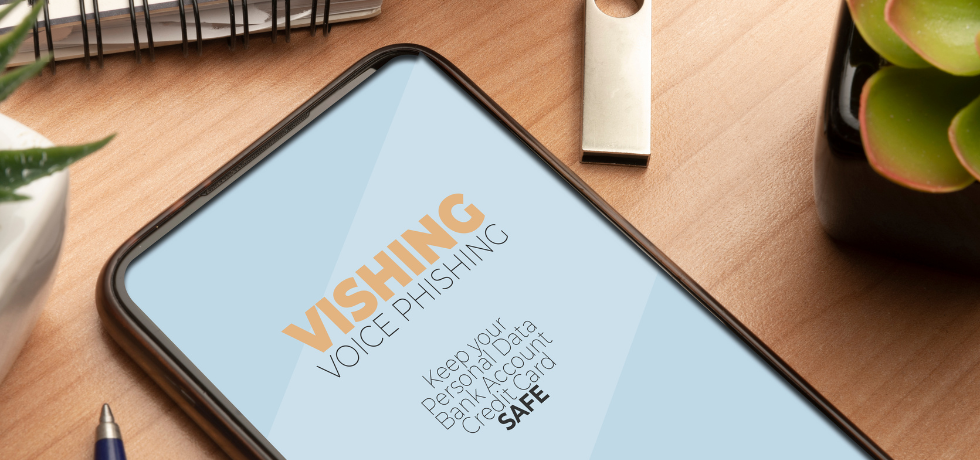
You know the saying, “You never get a second chance to make a first impression”? That’s onboarding emails in a nutshell. Welcoming a new employee or bringing on a new client? Get those emails right with the perfect onboarding email template, and you’re setting the stage for long-term loyalty, productivity, and satisfaction.
The numbers back this up: a strong onboarding process improves new hire retention by 82%. But why are onboarding emails crucial for healthy business relationships? They set the tone for how these relationships will evolve, and that includes defining expectations and promoting a sense of belonging.
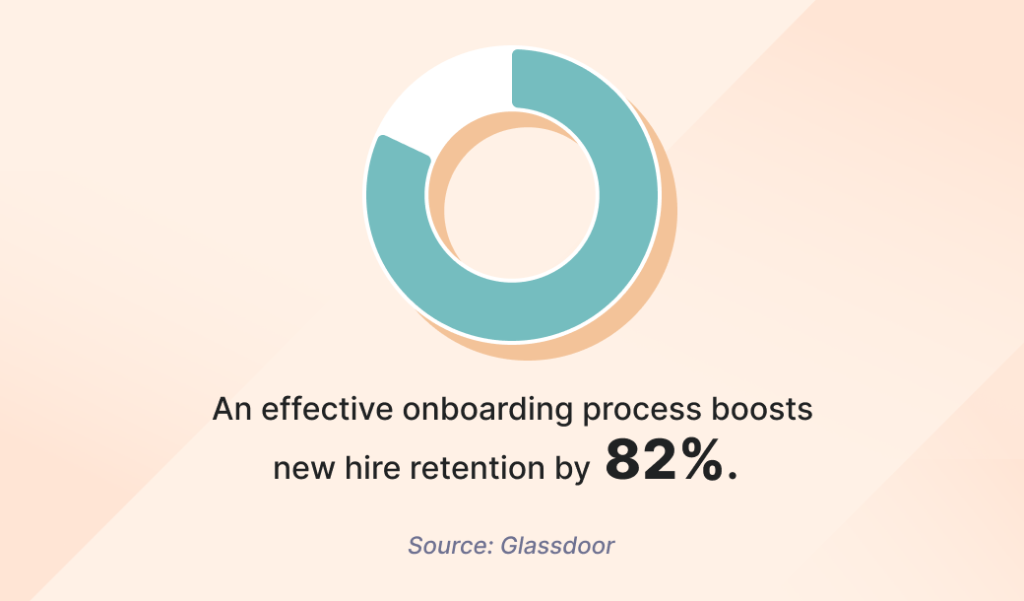
The article you’re about to read will help you redefine your onboarding process. It will even refine your client journey with the help of ready-to-use onboarding email templates, inspiring examples, and practical tips to make every email shine.
Ready to make onboarding emails your secret ally for better relationships? Let’s get to it!
15 Effective onboarding email templates
Let’s be honest – onboarding is chaotic. You’re juggling introductions and documentation, and trying to keep everyone excited about the process. Onboarding templates are the ultimate cheat code for seamless communication during the early stages. Nothing is left to chance, so you can focus on the personal touches that really matter.
Needless to say, they speed up the whole process and keep things consistent. Templates ensure every message has the right details, tone, and call-to-action, every time. This builds trust and, above all, creates a unique experience instead of simply sharing information. Streamlining the process makes life easier for you and way more engaging for them.
1. Welcome email to new employee
Subject line: Welcome to the team, [Employee name]!
Hi [Employee name],
Welcome to [Your company name]! We’re absolutely delighted to have you on board as our new [Job title]. You’re joining a team that’s passionate about [core company mission/values, e.g., delivering exceptional customer experiences], and we can’t wait to see the unique contributions you’ll bring.
Your first day is [date], and we’ve put together everything you’ll need to start your journey with confidence and excitement. Here’s a quick overview of what’s in store.
- Your onboarding schedule: This will give you a clear picture of your first few days, including meetings, introductions, and training sessions: [onboarding schedule link]
- Employee handbook: Think of this as your go-to guide for all things [Your company name] — our policies, culture, and resources to help you settle in smoothly: [handbook/relevant document link]
- Your workspace and tools: Your [workstation/login credentials/software access] will be ready when you arrive. [Add details if applicable, e.g., “Our IT team will email you your login credentials a day before.”]
We know that starting a new job can be both exciting and overwhelming, so please don’t hesitate to reach out if you have any questions or need assistance. You can contact [Contact name] at [email address] or give us a call at [number].
We’re confident you’ll do amazing things here, and we’re so excited to watch you grow in your new role. [Add a personal or cultural touch, e.g., “P.S. Don’t forget to join us for our weekly team coffee chat on Friday mornings — it’s a great way to get to know everyone!”]
Looking forward to seeing you shine!
Warm regards,
[Your name]
[Your position]
[Your contact information]
2. New employee introduction email to clients
Subject line: Exciting news — meet our new [Job title]!
Dear [Client name],
We’re thrilled to share some exciting news with you — [Employee name] has joined our team as our new [Job title]!
[Employee name] comes to us with extensive experience in [employee expertise], bringing a wealth of knowledge and skills that will help us continue delivering the exceptional service you’ve come to expect from [Your company name]. They’ll be working closely with you on [area/project], and we’re confident you’ll find them to be an incredible partner.
Here’s a little more about [Employee name].
- Background: [Brief mention of their professional background, e.g., “Over 10 years of experience in [industry/field] with a focus on [skill].”]
- Specialization: [Highlight specific expertise, e.g., “Known for their innovative approach to problem-solving and passion for [area].”]
- Fun fact: [Optional: Add a fun or personal touch, e.g., “When not at work, [Employee name] enjoys [hobby/interest].”]
Feel free to contact [Employee name] directly at [email address] for any assistance or questions related to [project/service]. They’re eager to connect with you and contribute to our shared success.
Please join us in giving [Employee name] a warm welcome to the team!
Best regards,
[Your name]
[Your position]
[Your contact information]
3. 30-day check-in email for new employees
Subject line: Checking in — how’s your first month going?
Hi [Employee name],
It’s hard to believe it’s been 30 days since you joined [Your company name] — time flies when you’re doing amazing work!
We hope your first month has been a smooth and exciting journey as you’ve settled into your role. We’d love to hear your thoughts:
- How’s everything going so far?
- Are there any challenges you’re facing or areas where you’d like additional support?
- Is there anything we can improve to make your experience even better?
Your feedback matters, and we’re committed to ensuring that you have everything you need to succeed. Feel free to reply directly to this email or schedule a quick chat here: [scheduler link]
Also, if there’s something you’ve particularly enjoyed about your time here, we’d love to hear about that too!
Looking forward to catching up and hearing your insights.
Best regards,
[Your name]
[Your position]
[Your contact information]
4. Welcome email for remote employees
Subject line: Welcome to [Your company name] — let’s get you connected
Hi [Employee name],
Welcome to the team! We’re so excited to have you join us as [Job title], and we’re here to make sure that your remote onboarding experience is smooth and stress-free.
To help you hit the ground running, here’s your first-day checklist.
- Access your tools and resources: Use these login credentials to get started: [platform/tool 1 link]; [to platform/tool 2]. If you have trouble accessing anything, our IT team is just a message away at [IT contact information].
- Get familiar with your schedule: Your first-day meetings and introductions are outlined here: [schedule link]
- Connect with your team: We’ve arranged a [meeting/session] at [time]. This is a great opportunity to meet your new colleagues and get to know the team dynamic.
We know that working remotely can feel a little different at first, but we’re here to support you every step of the way. If you have any questions or need assistance, don’t hesitate to reach out to me or your manager.
Can’t wait to see all the amazing things you’ll accomplish with us!
Cheers,
[Your name]
[Your position]
[Your contact information]
5. Onboarding email template for freelancers
Subject line: Welcome to [Your company name] — here’s what you need
Hi [Freelancer name],
We’re thrilled to have you join the [project] team! Your expertise in [skill/area of expertise] is a perfect fit for our team, and we’re looking forward to a successful partnership.
To help you hit the ground running, here’s what you’ll need to get started.
- Submit required documents: Please upload your signed contract and tax forms here: [link]
- Access your tools: Log in to our project platform to access your tools and resources: [platform link]. Your login credentials have been emailed separately.
- Review key project details: [optional: include a link to a brief/onboarding guide, if relevant]
If you need any help or run into issues, feel free to contact [Contact name] at [email address] or [number]. We’re here to ensure that your onboarding experience is seamless and productive.
We’re excited to see the impact of your work on [project]. Thanks again, and welcome to the team!
Best regards,
[Your name]
[Your position]
[Your contact information]
6. New manager onboarding email template
Subject line: Welcome to leadership at [Your company name]!
Hi [Manager name],
Congratulations on your new role as [Job title]! We’re thrilled you’re stepping into this leadership position and can’t wait to see the impact of your expertise and vision on [team/project].
To set you up for success, here’s what we’ve lined up for your onboarding.
- Leadership handbook: Dive into [Your company name]’s leadership resources to familiarize yourself with our values, goals, and expectations: [leadership handbook link]
- Leadership training: Join us for [training details, e.g., “interactive workshop on effective team management”, “upcoming leadership summit”]: [schedule link]
- Connect with key stakeholders: During your first week, we’ll schedule introductions with other leaders and your direct reports to ensure a smooth transition.
We’re here to support you every step of the way. Feel free to schedule a one-on-one chat with me using this link: [scheduler link]
We’re excited about what’s ahead and look forward to seeing you thrive as part of our team!
Best regards,
[Your name]
[Your position]
[Your contact information]
7. Welcome email for interns
Subject line: Welcome to [Your company name], [Intern name]!
Hi [Intern name],
Welcome to [Your company name]! We’re thrilled to have you join us as an intern and can’t wait to see the fresh ideas and energy you’ll bring to the team.
Here’s what you need to know to get started.
- First-day schedule: Check out your schedule for day one here: [link]. It includes introductions, orientation, and a rundown of what to expect during your internship.
- Meet your team: You’ll be working closely with [Team name] team. Here’s a quick overview of who’s who: [team details & contact information]. Everyone is looking forward to meeting you!
- Resources to review: To help you hit the ground running, we’ve prepared some resources for you to review before your start date: [handbook/guides/training material links].
If you have any questions or need assistance before your first day, don’t hesitate to contact [Contact name] at [email address]. We’re here to ensure that your onboarding experience is smooth and enjoyable.
We’re so excited to have you as part of the team and can’t wait to see you shine during your internship!
Best regards,
[Your name]
[Your position]
[Your contact information]
8. General customer onboarding email template
Subject line: Welcome to [Your company name] — let’s get started!
Hi [Customer name],
Welcome to [Your company name]! We’re thrilled to have you on board and can’t wait to help you get started with [Your product/service].
To make the most out of your experience, here are a few quick steps to get you up and running.
- Explore our guide: [guide/tutorial link]
Learn the ins and outs of [Your product/service] with our step-by-step instructions. - Set up your account: [account setup link]
Log in and personalize your [Your product/service] for your needs. - Reach out anytime: Our support team is here to help you every step of the way. Have questions? Need advice? Email us anytime at [email address].
We’re here to make sure that your journey with [Your product/service] is smooth, successful, and enjoyable. If there’s anything we can do to help, don’t hesitate to let us know.
Let’s get started!
Cheers,
[Your name]
[Your position]
[Your company name]
9. Client onboarding email template
Subject line: Welcome to [Your company name] — next steps
Dear [Client name],
We’re thrilled to welcome you to [Your company name] and excited to kick off our partnership!
Here’s what’s next:
- Kickoff meeting: Let’s connect to discuss your goals and expectations. Date/time: [date/time]; meeting link/location: [link/address]
- Onboarding materials: To help you get familiar with our process, here are the resources you’ll need: [onboarding guide/welcome packet link] [platform login/access details, if applicable]
- Your point of contact: Meet [Contact name], your dedicated [Job title, e.g., Account manager]. They’ll be your go-to for all things related to [area/project]. You can reach them directly at [email address] or [number].
If you have any immediate questions or concerns, don’t hesitate to contact me at [email address]. We’re here to ensure a smooth and successful start.
Looking forward to collaborating and achieving great things together!
Best regards,
[Your name]
[Your position]
[Your company name]
10. Software onboarding email template (B2B SaaS)
Subject line: Let’s get you set up on [Your software name]
Hi [Client name],
Welcome to [Your software name]! We’re excited to have you on board and can’t wait to help you get the most out of our platform. To make your onboarding seamless, here’s what to do next.
- Log in to your account: Access your account and explore the platform here: [link]
- Schedule a walkthrough: Our team is ready to guide you through the features and help you set everything up. Book a time that works for you: [scheduler link]
- Access training materials: Get up to speed with our resources, including guides and videos, here: [link to training materials].
We’re committed to your success, so if you have any questions or run into any issues, don’t hesitate to contact our support team at [email address] or [number].
We can’t wait to see how [Your software name] helps you [benefit, e.g., “streamline your processes” or “grow your business”].
Happy onboarding!
Best regards,
[Your name]
[Your position]
[Your company name]
11. Retail customer welcome email
Subject line: Welcome to [Your company name] — here’s something special just for you
Hi [Customer name],
Welcome to [Your company name]! We’re so excited you’ve joined our community, and we can’t wait to be part of your journey. To kick things off, we’ve got a special treat just for you:
🎁 Use code [code] at checkout to enjoy [discount/freebie]!
Start exploring our bestsellers here: [product links]. You’re sure to find something you’ll love!
If you have any questions or need assistance, our customer support team is here to help. Just reply to this email or contact us at [email address].
Thank you for choosing [Your company name]! We’re looking forward to being a part of your story and helping you discover amazing [products/services].
Cheers,
[Your name]
[Your position]
[Your company name]
12. Onboarding email template for e-commerce clients
Subject line: Welcome to [Your company name] — your first purchase awaits!
Hi [Customer name],
Welcome to [Your company name]! We’re so excited to have you join our community and can’t wait for you to experience the amazing products and deals we’ve got in store.
Here’s how to get started.
- Explore our collection: Find your favorites or discover something new here: [shop link].
- Need assistance? Our customer care team is available 24/7 to help you with anything you need. You can reach us at [email address].
We’ve added a special treat to your account as a welcome gift — check it out when you log in!
Thank you for joining the [Your company name] family. We’re here to make every shopping experience simple, exciting, and rewarding.
Cheers,
[Your name]
[Your position]
[Your company name]
13. Onboarding email template for returning customers
Subject line: Welcome back, [Customer name]!
Hi [Customer name],
Welcome back to [Your company name]! We’re so happy to see you again, and we’ve got some exciting updates since your last visit.
- Discover what’s new: Explore our latest products and services here: [new product/service link]
- Exclusive offers for loyal customers: As a returning customer, you’re eligible for these special deals: [special offer details]
- Your account: Log in to your account to see your recent activity, saved items, and more: [account link]
Your loyalty means the world to us, and we’re committed to making every experience with [Your company name] even better than the last. If there’s anything we can do to assist, don’t hesitate to reach out to our customer care team at [email address].
Thank you for choosing [Your company name] again — we’re excited to continue serving you!
Best regards,
[Your name]
[Your position]
[Your company name]
14. Training program onboarding email template
Subject line: Welcome to [Your training program name]!
Hi [Trainee name],
Welcome to [Your program name]! We’re so excited to have you join us for this learning journey. To help you get started, we’ve prepared everything you’ll need.
- Training schedule: Check out the program timeline and session details here: [link]
- Pre-session materials: Review these resources before our first session to ensure that you’re ready to dive in: [material links]
- Stay connected: If you have any questions or need assistance, feel free to contact [Contact name] at [email address] or [number].
We’re here to support you every step of the way and can’t wait to see how you grow through this program. Let’s make this an incredible learning experience!
Best regards,
[Your name]
[Your position]
[Your training program name]
15. Event onboarding email template
Subject line: Welcome to [Your event name] — here’s what you need to know
Hi [Attendee name],
We’re so excited to have you join us for [Your event name] on [date]! It’s going to be a fantastic event, and we’ve got everything lined up to make your experience seamless and enjoyable.
Here’s everything you need to know.
- Event schedule: Check out the agenda to see what’s happening and when: [link]
- Venue/location: [Optional: Include parking details, map, or instructions for virtual attendance, if applicable.]: [link]
- Key highlights: [Optional: Mention keynote speakers, exciting sessions, or activities attendees can look forward to.]
If you have any questions or need assistance, don’t hesitate to contact us at [email address].
We’re counting down the days to [Your event name], and we can’t wait to see you there!
Best regards,
[Your name]
[Your position]
[Your event team/company name]
Launch email campaigns with Textmagic
Ready to use these templates in real campaigns? Create, send, and track business emails & SMS in one single platform.
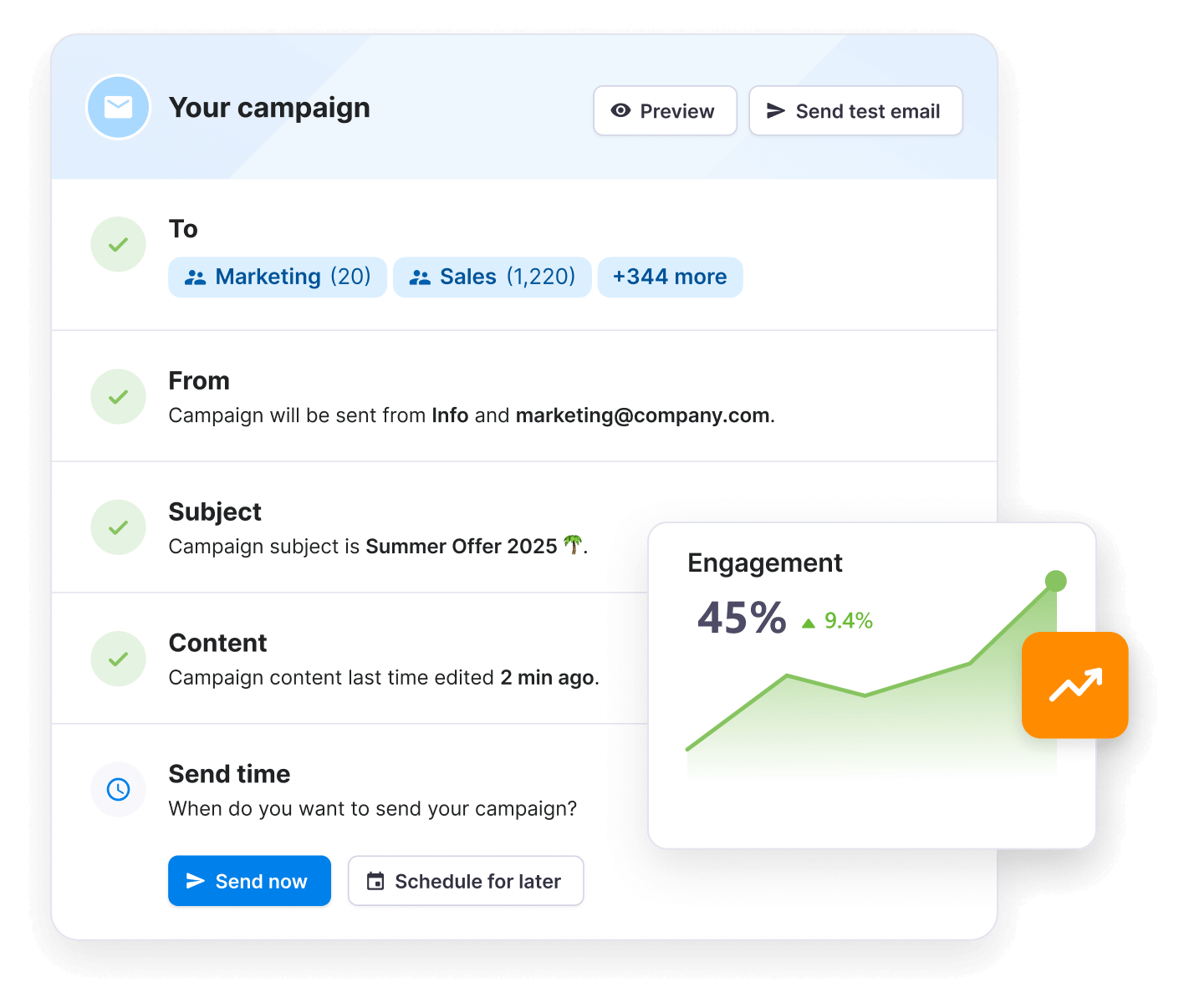
Five onboarding email examples for inspiration
Here are some real-life examples of onboarding emails from various companies.
Bitdefender
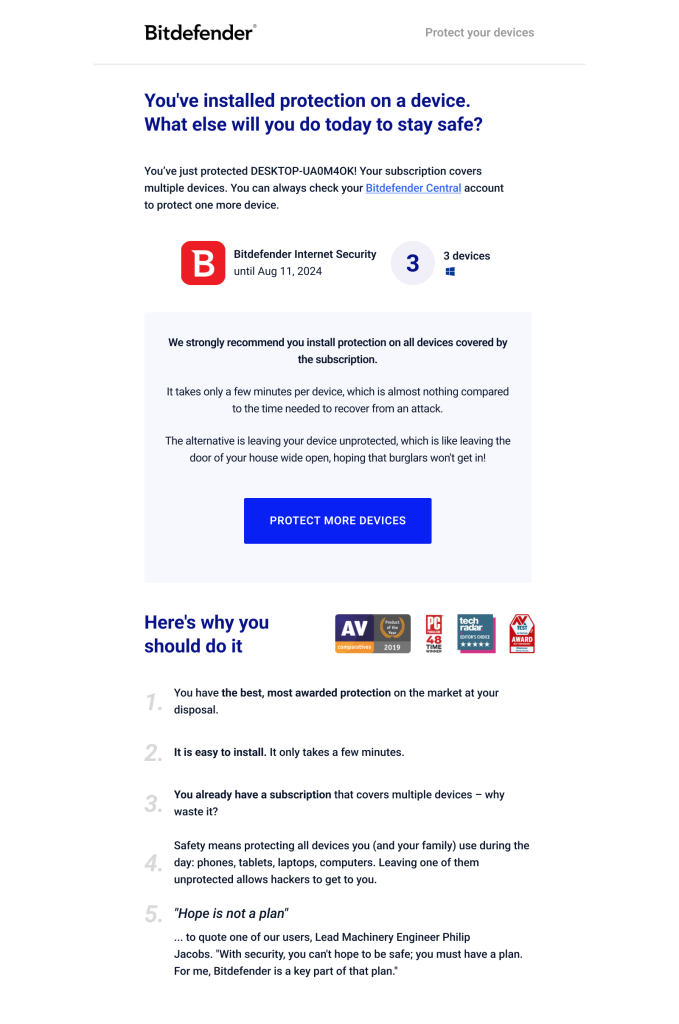
Why we like it
- Compelling reasons to act: The email lists clear benefits of installing protection on all devices.
- Professional tone with a personal touch: The email balances professionalism with user-centric language, making the message approachable yet credible.
- Expert testimonial: The email includes a relatable quote from a user, which adds authenticity and reinforces the importance of having a proactive security plan.
I’Velo
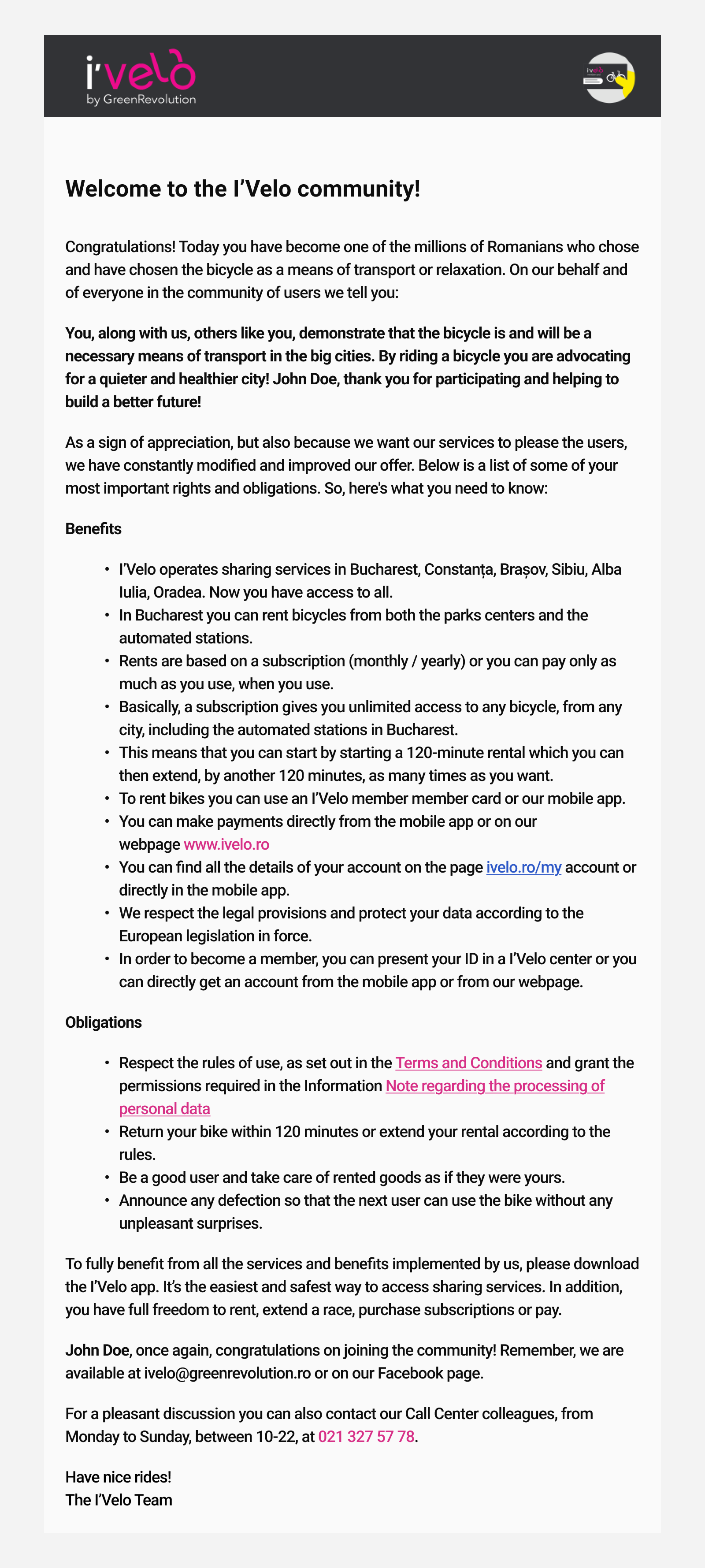
Why we like it
- User-centric support: Multiple contact options are provided, ensuring that users feel supported and can easily reach out for assistance.
- Clear explanation of benefits: The email provides a detailed list of benefits, ensuring that users immediately understand the service’s value.
- Appeals to shared values: The email ties bike-sharing to broader goals like sustainability and urban health, fostering a sense of belonging to a mission-driven initiative.
Udemy

Why we like it
- Inspirational welcome message: The email opens with a warm tone, welcoming the user to a “world of possibilities” and encouraging exploration. This sets a positive and aspirational tone, aligning with Udemy’s mission to empower lifelong learning.
- Testimonial for credibility: Including a learner’s quote adds authenticity and reassurance about the platform’s impact, building trust with new users.
- Mobile accessibility: Promoting the app download ensures users can easily access courses on the go, increasing engagement and convenience.
Textmagic
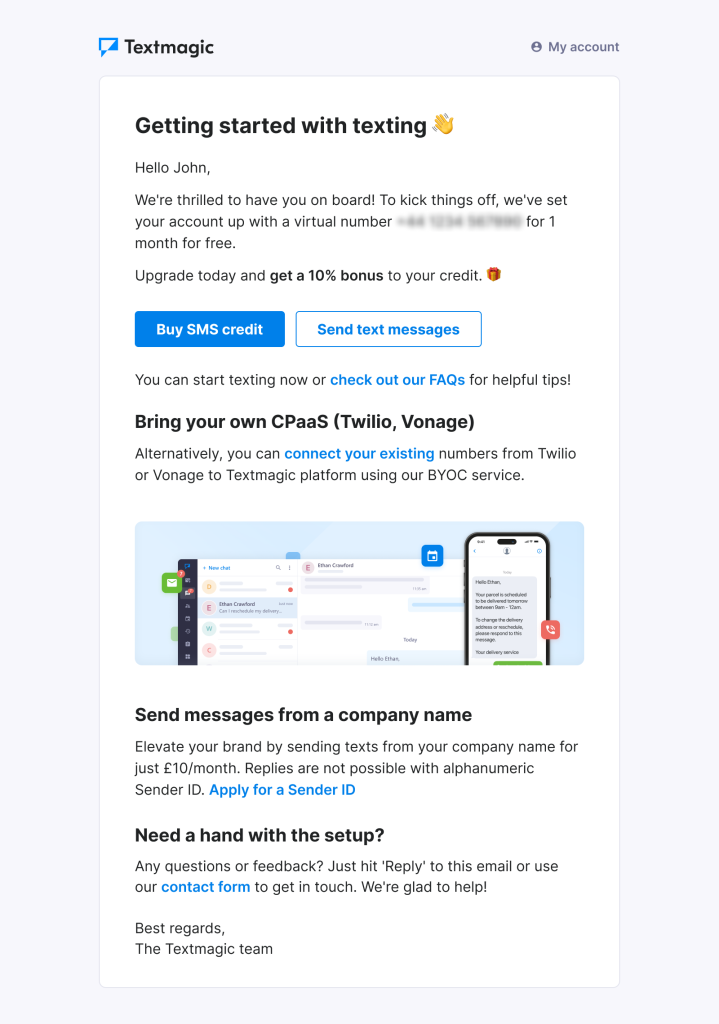
Why we like it
- Upselling opportunity: Our email suggests using a branded Sender ID for £10/month. It offers a premium feature that enhances professional branding while clearly stating its limitations.
- Immediate value proposition: Our email highlights a key benefit upfront — a free virtual number for one month. This creates instant value for the recipient and encourages them to explore the service.
- Flexible options for advanced users: Our email introduces the Bring your own CPaaS (BYOC) service, appealing to tech-savvy users who’re already using Twilio or Vonage. This highlights our platform’s versatility and integration capabilities.
Edicy
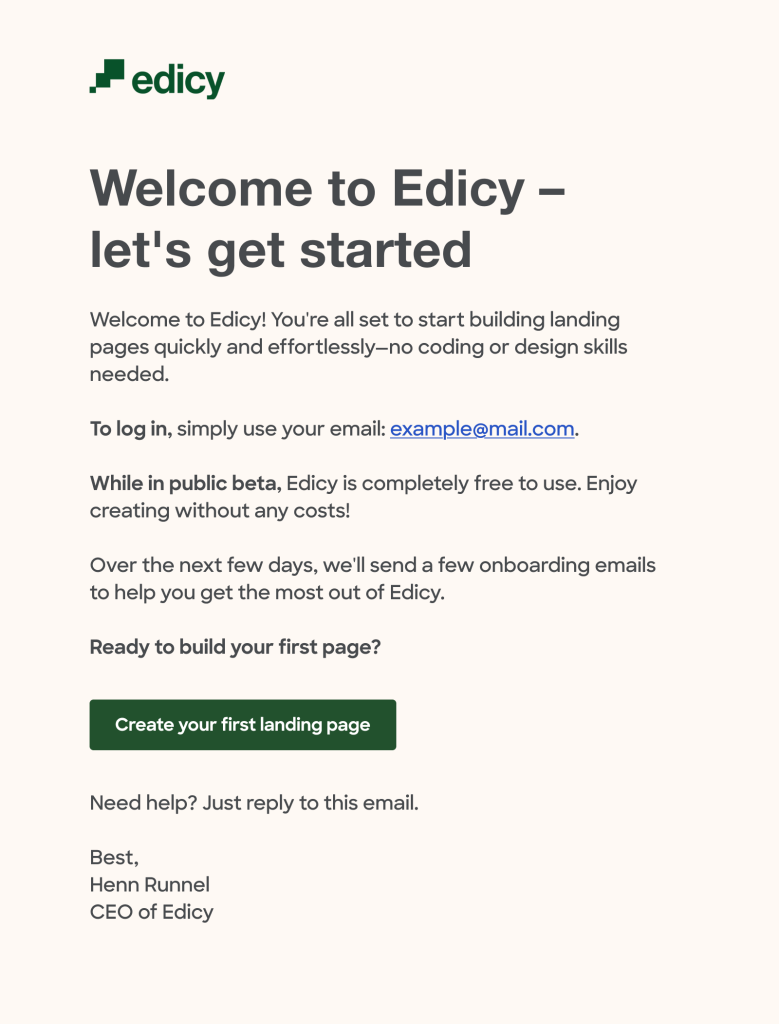
Why we like it
- Personal touch from the CEO: Signing the email from the CEO adds a personal and authoritative touch, enhancing credibility and making the communication feel more genuine.
- No-risk offer: The email emphasizes that the platform is free during the public beta phase, lowering barriers for new users and encouraging them to explore the tool without hesitation.
- Step-by-step guidance: The email mentions that additional onboarding emails will follow, reassuring users that they’ll receive ongoing support and tips for maximizing the platform’s potential.
How to welcome a new employee via email right
These are the best practices for crafting effective employee onboarding emails.
1. Time emails for maximum impact
You want your email to arrive when excitement is high, not buried under a pile of unread messages. Send the welcome email within 24 hours of their offer acceptance.
Pro tips
- Include a sneak peek of what’s ahead, like meeting their team or a fun fact about the company culture. This keeps the email engaging and leaves them excited about what’s next.
- Follow up a day or two before their start date with an email titled: “Ready for day one? Here’s what to expect!”
2. Start with a warm and welcoming tone
This isn’t the time for corporate jargon. Be friendly, approachable, and excited to have them on board. Make it feel personal.
Example
3. Include clear, actionable next steps
Don’t leave them guessing about what to do next. Use headers, links, and bullet points to make everything crystal clear.
Example
“What you need to do before your first day:
- 📄 Complete your onboarding forms: [forms link]
- 📅 Mark your calendar for orientation: [date and time]
- 🧑💻 Set up your email account: Instructions here: [link]”
4. Personalize emails for a stronger connection
Make the email feel tailored to them, not just another template you fired off. Reference their role, team, or even small details from their interview.
Example
“We know your passion for [skill/interest they mentioned] will bring incredible value to our [Team name] team. Everyone can’t wait to meet you!”
5. Ensure that the email aligns with company culture
Your email should reflect your company’s identity, starting with the tone and ending with the visuals. Whether you’re laid-back or more formal, make sure that it’s cohesive.
Example
6. Follow up with relevant resources
End on a helpful note. Give them all the tools they need to hit the ground running, plus a way to reach out if they’re unsure about anything.
For an extra personal touch, include a link to your company’s welcome video or an intro message from the CEO.
Example
7. Use tools to simplify employee onboarding
The right tools automate email responses, track progress, and ensure a smooth experience for both HR teams and new hires. Here are some platforms that take the strain out of lengthy background checks and endless paperwork.
BambooHR
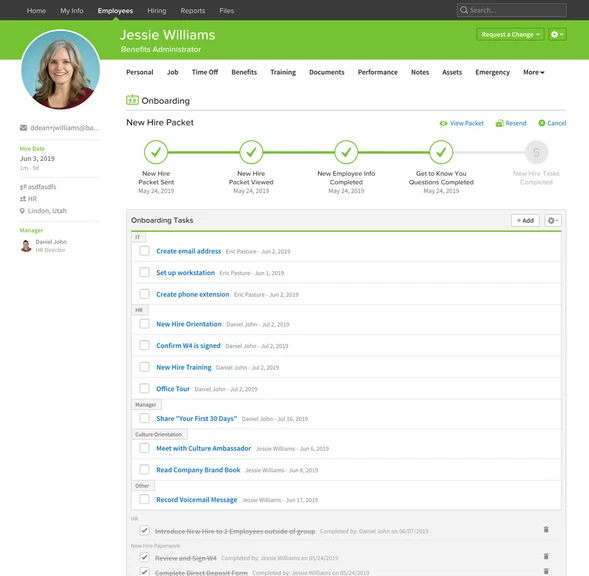
Image source: appsumo.com
BambooHR is an HR software platform with a dedicated onboarding module. It automates welcome emails, organizes onboarding tasks, and tracks employee progress. The platform is ideal for small to medium-sized businesses.
Key features
- E-signature integration for a paperless process
- Automated onboarding emails with personalized content
- Centralized checklist to track tasks like form submissions and document signing
Workday
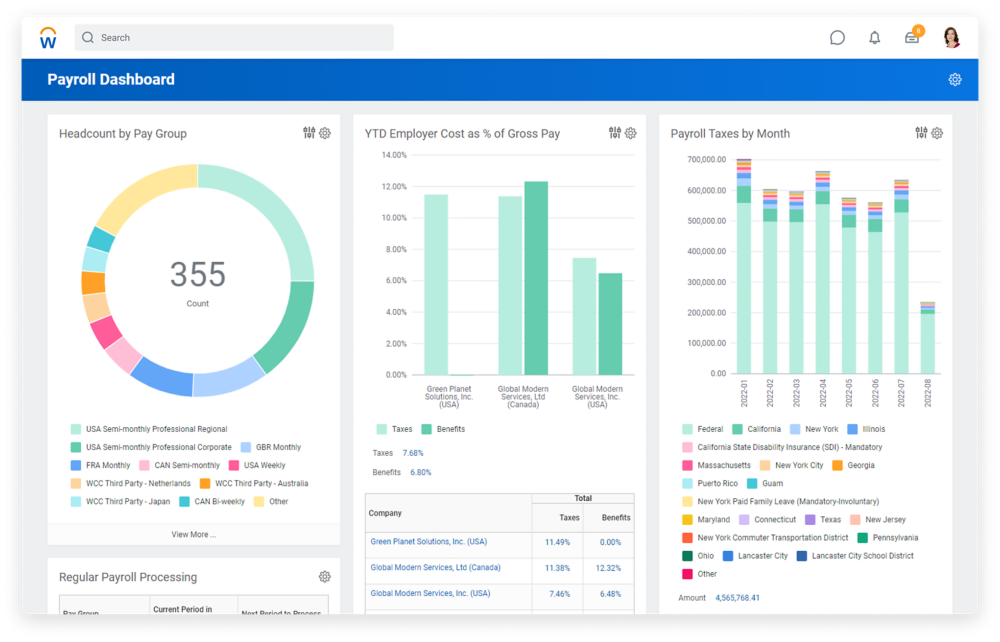
Image source: workday.com
Workday’s Onboarding module automates administrative tasks and provides a centralized hub for new hire documents and activities.
Key features
- Automated emails and reminders for onboarding steps
- Dashboard for new hires to access resources and forms
- Completion tracking of compliance-related tasks (e.g., I-9 forms)
Zoho People
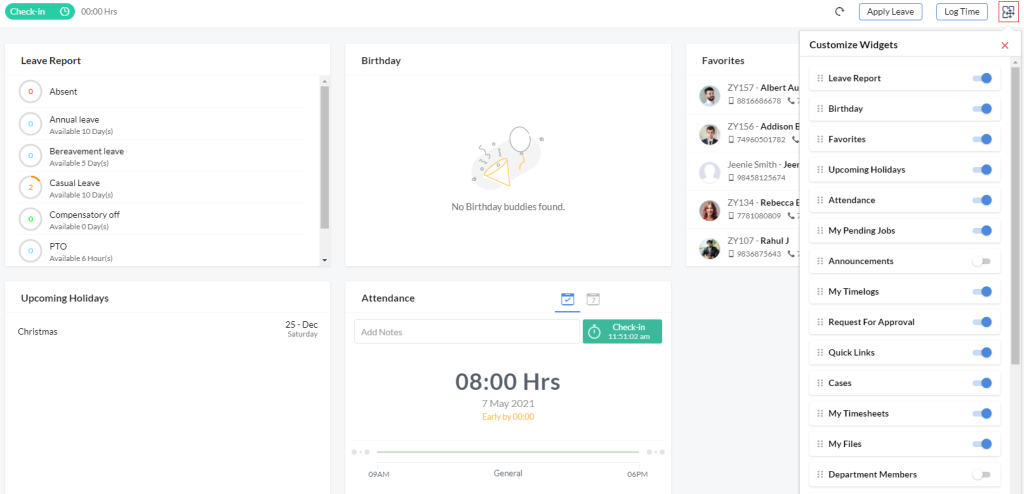
Image source: zoho.com
Zoho People is an HR platform tailored for small to medium-sized companies. Its onboarding module helps automate email communication and track onboarding progress.
Key features
- Centralized dashboard to manage onboarding stages
- Integration with Zoho’s suite of tools for added efficiency
- Automated workflows for welcome emails and task reminders
Craft the perfect onboarding email strategy
Onboarding emails set the tone for long-lasting, positive relationships. Employees see them as a logistics guide for what to bring, when to show up, who to ask for help, or as an introduction to your company’s values.
For clients, it’s more like a walk-through for your product or service, making it easy to get started and next to impossible to second-guess their decision to work with you.
When you use the right kind of communication, everyone feels special, supported, and ready for what’s ahead. So, getting onboarding emails just right is not just the start of a journey; it’s the certainty that the journey will be worth remembering, and that is the key to business success.
Onboard, retain, and nurture with Textmagic
Personalize onboarding emails, set triggered follow-ups, and monitor engagement in an all-in-one platform.

Frequently Asked Questions (FAQs)
Start with a clear subject line and a personalized greeting. Outline next steps, provide helpful resources, and include a clear call to action. Keep the tone friendly and the message concise to avoid overwhelming new employees, clients, or users.
Briefly state your name, role, and how you’ll support the recipient during their onboarding journey. The introduction should be confident and approachable, setting a helpful and welcoming tone.
A welcome email is a single touchpoint to greet the user, client, or employee. An onboarding email is part of a sequence that walks them through key steps, such as training, setup, or communication procedures, to help them get started smoothly.
Use a CRM, email marketing platform, or HR software to trigger emails based on user or employee milestones, such as account creation, contract signing, or day-one arrival. Automation helps deliver consistent onboarding resources across teams and customer journeys alike.
Yes. With Textmagic, you can schedule and automate both SMS and email onboarding messages, ensuring timely delivery of welcome texts, setup guides, and reminders to new users, clients, or employees.
Most are not. While employee logins or client setup confirmations may be transactional, the broader onboarding journey is educational or promotional and must include consent and opt-out options if sent via email marketing platforms.
Related articles
9 Results-driven customer engagement models
Offering a great product or service is no longer eno...
How to promote a new product launch with SMS marketing
Launching a new product is exciting for any business...
SlickText vs. Textmagic: What you need to know before you choose
Choosing the right SMS marketing platform can signif...
Text messaging for recruitment: 25+ Recruitment message samples to hire better
A good recruiting message example means starting the...
What is vishing? Unmasking voice phishing scams and techniques
Vishing, an insidious blend of voice communication a...




